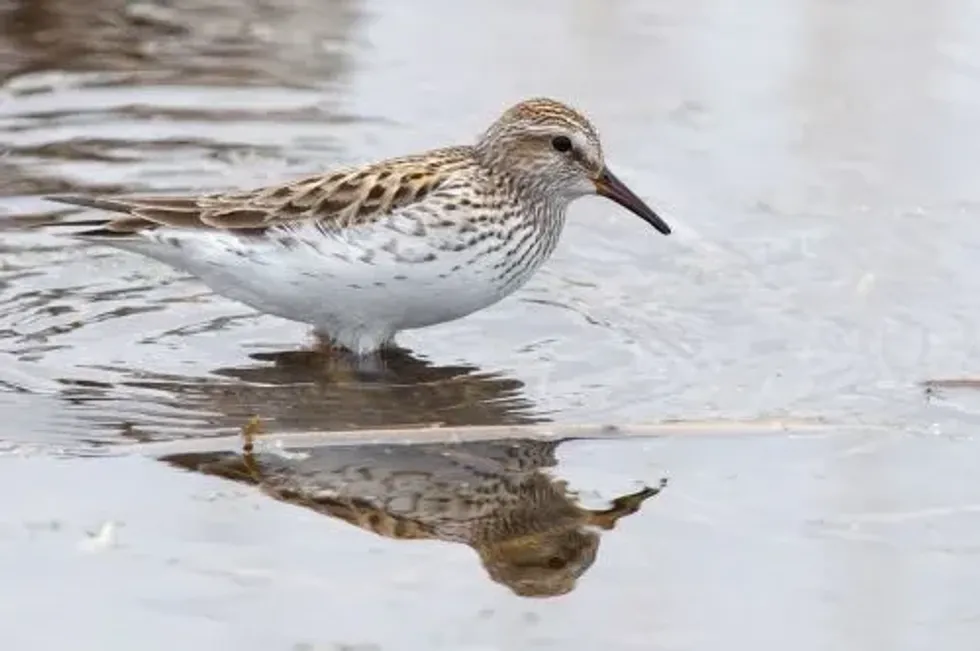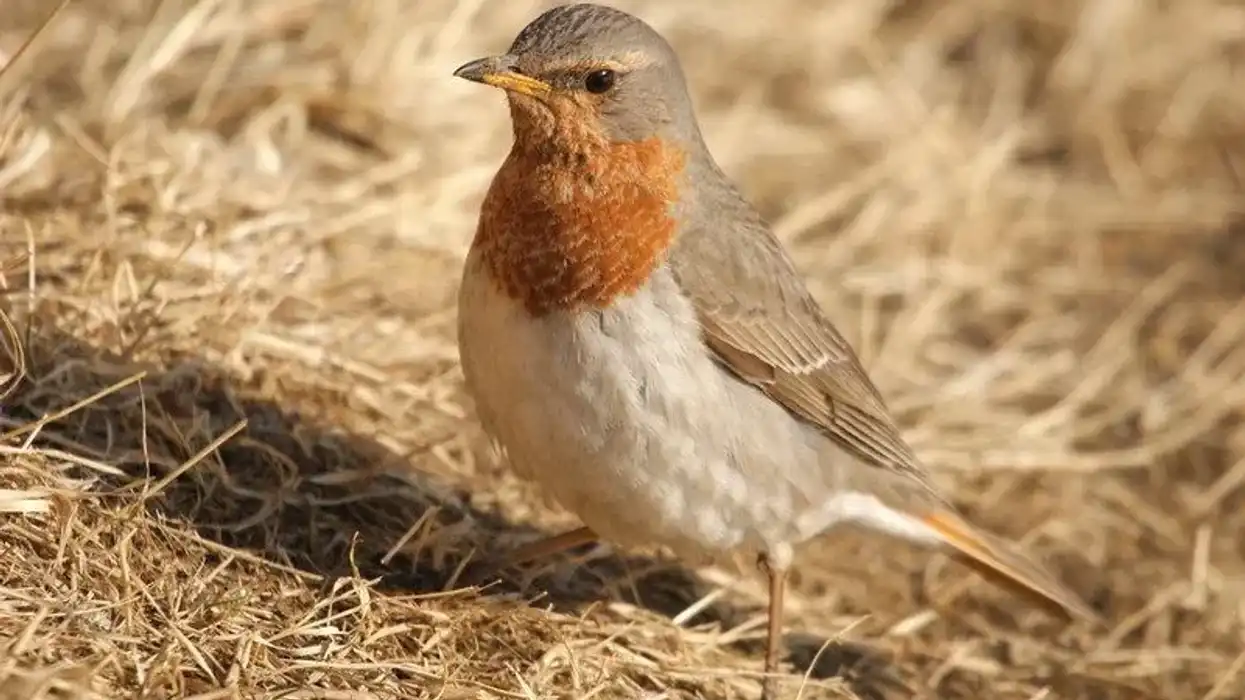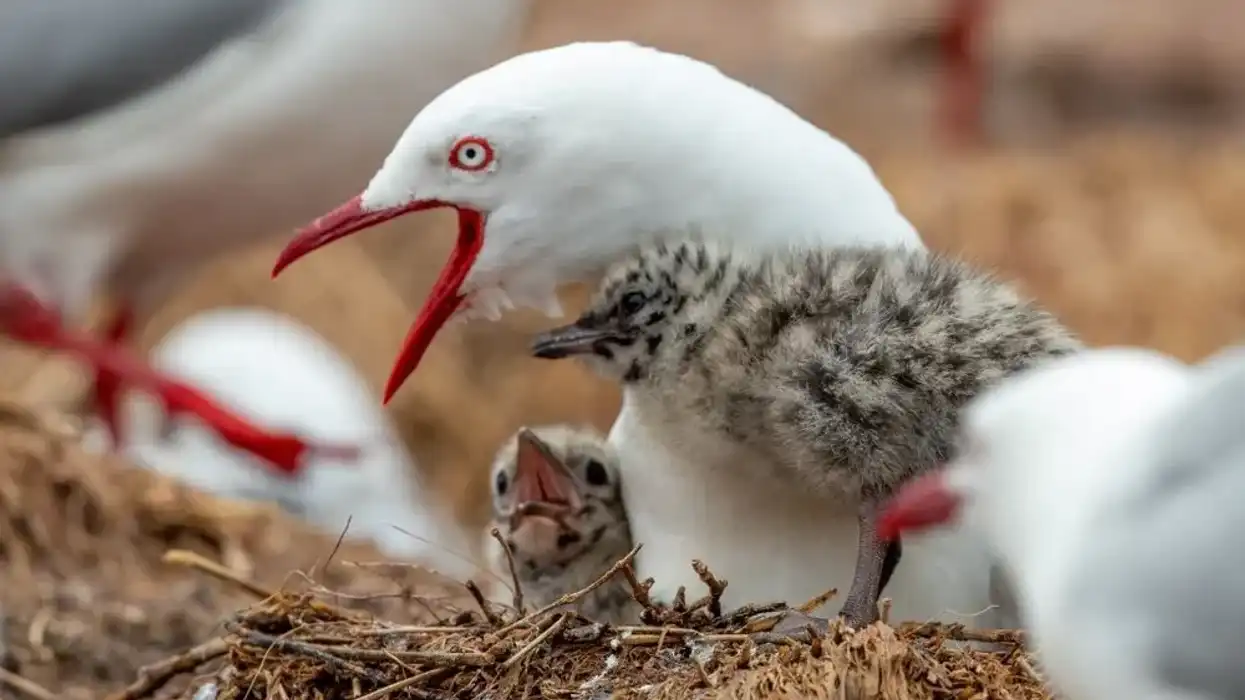The white rumped sandpiper (Calidris fuscicollis) is a migration bird and a species of shorebird. They are of the order Charadriiformes, family Scolopacidae, and are part of a group of sandpipers or waders.
Shorebirds are a group of species of birds found in the mud, ground, or sand near bodies of water. They are typically found in North America and sometimes in South America. This means that they often fly to different locations depending on the season and for breeding.
The rump of a bird is the area of its body just above the tail feathers. Don't be fooled, even though they are named a 'white rumped' sandpiper, sometimes the rump is actually dark brown!
These birds are a species known for their graceful long wings and the males who are very vocal. Thankfully, these birds are not endangered and there are plenty to be seen in the wild.
They have a conservation status of Least Concern. However, their populations are said to be decreasing. This is mostly due to habitat loss because of climate change.
The high Arctic is in danger and is no longer safe for all birds. It is important to learn about climate change and nature's amazing creatures so that we can preserve our planet and its animals forever.
To learn more, read about the white rumped sandpiper in this article. It may even get you into bird watching!
Interested in other feathery friends? Read our articles about the least sandpiper and Mayer's parrot here.
White Rumped Sandpiper Interesting Facts
What type of animal is a white rumped sandpiper?
The white rumped sandpiper (Calidris fuscicollis) is a shorebird. Shorebirds are commonly found, you guessed it, by the shore. This could be the shore of the sea, freshwater, and even flooded fields. They can also be called waders because they wade through the sand and mud to find food.
What class of animal does a white rumped sandpiper belong to?
A white rumped sandpiper is a bird from the Aves class.
How many white rumped sandpipers are there in the world?
There are plenty of white rumped sandpipers worldwide, and it is unclear the exact population of this bird. Some research suggests that the population is about 1.7 million.
Where does a white rumped sandpiper live?
You can find white rumped sandpipers in the tundra, by freshwater and also by the ocean.
What is a white rumped sandpiper's habitat?
This species is mostly found living in the arctic and are birds of North America. They have even be found as far north as Ellesmere and the Devon islands.
Here, they can be found in vegetated areas of the arctic tundra during the breeding season. Tundra is a cold and windy area containing plants that have adapted to these conditions. During migration season, they are found in wetlands and flooded fields.
In the winter, their habitat is more freshwater and saltwater areas like estuaries, ponds, streams, lagoons, and marshes. These birds can also be found in South America in similar habitats as well as rivers, beaches, and lakes.
Who do white rumped sandpipers live with?
They live with other white rumped sandpipers and their family of young until they leave the nest. Male sandpipers are polygynous, meaning that they mate with more than one female.
Once females have laid eggs, males typically depart the nest. Females build and incubate their nests and female white rumped sandpipers with the same male mate often nest near each other. They can also be found in a flock with other species of shorebirds.
How long does a white rumped sandpiper live?
There isn't much information on the lifespan of these birds. However, it is said that they can live up to seven years.
How do they reproduce?
These birds reproduce sexually. Two mates get together through courtship. Males establish breeding grounds and the females will pick the male for courting. Once they have paired up, they will fly side-by-side at about 32.8-82 ft (10-25 m) in the air.
The male will then hover over the female, making noises similar to oinking or buzzing. Once back on the ground, males will display their wings through a dance. Females engage in this courtship and breed once a year, whereas males breed multiple times a year.
After courtship on breeding grounds, females build a nest for their eggs from moss, grass, and other plants. Breeding grounds are typically on wetlands of arctic tundra. They produce eggs that are pale green with markings. Males and females are at least one year old when they start to reproduce.
What is their conservation status?
This species of bird has a conservation status of Least Concern. Actually, this species is protected by laws that protect all migration birds in North America. These laws ban people from buying or selling migration birds of Northern America
White Rumped Sandpiper Fun Facts
What do white rumped sandpipers look like?
White rumped sandpipers are shorebirds with long wings that are longer than other similar species of order Charadriiformes, family Scolopacidae, and genus Calidris. Their breeding plumage is white and brown with rust-colored highlights. Their breast is stippled with dark markings.
They have pale white striped markings on their eyes and a thin dark beak. Adult white-rumped sandpipers have brown tail feathers whereas a juvenile's tail is more gray-black.
They have a white patch of feathers on the underside of their tail that is only visible during flight. These white feathers are actually upper tail coverts, which are feathers that cover the base of the tail. Females and males are hard to tell apart because they look the same.
How cute are they?
These birds are quite cute! They have intricate markings on their feathers and are even cuter when they are chicks.
How do they communicate?
White rumped sandpipers make noises to communicate with each other. Males are very vocal and use calls. Their flight calls sound like a high-pitched but weak noise.
They make different noises and calls depending on whether they are on their breeding grounds or not. When outside their breeding grounds, males make a noise described as 'prink prink'. When on their breeding grounds, they make more of a buzzing sound.
Males are typically seen making noises and visual displays when trying to court females. Males have also been known to defend their territory and can even attack other birds. Interestingly, females are quite the opposite and do not make much noise at all!
How big is a white rumped sandpiper?
These birds range about 6.8-8 in (17-20 cm) in length, from head to the tips of their tails. They are not very tall birds. They are almost five times smaller than a golden eagle. They do have long tails for a shorebird, with the range of their wingspan 4.6-5 in (11.7-12.6 cm).
How fast can a white rumped sandpiper fly?
They fly pretty swiftly, with speeds up to 50 mph (80 kmph). Migration happens from mid-August to early September. They can fly up to 2485 mph (4000 kmph) in one flight session. They can even fly from Alaska and islands outside Antarctica to southern South America.
How much does a white rumped sandpiper weigh?
Both sexes have a mass range of 1.41-2.11 oz ( 40-60 g).
What are their male and female names of the species?
Males and females are both called white rumped sandpipers.
What would you call a baby white rumped sandpiper ?
A baby white rumped sandpiper is called a chick, just like other baby birds. These birds are bred between June and August, the breeding season. They often produce on average four eggs. These eggs take 22 days to hatch, and the young chicks take 16-17 days to fledge and leave the nest.
What do they eat?
The diet of this bird is mostly invertebrates, animals without backbones. This includes snails, sea worms, crustaceans, and insects. They find their food by digging in the mud, sometimes with their whole bill deep in the mud. If they don't find any food, they move location and dig again. Sometimes, plants and seeds are also part of their diet.
Are they dangerous?
There is no evidence that they are dangerous to humans, but males are said to be aggressive when protecting their territory from other male birds and similar species of sandpipers.
Would they make a good pet?
They would not make good pets as they belong in the wild. It is also illegal to keep one as a pet, as they are one of the birds of North America protected by laws against buying and selling.
Did you know...
The white rumped sandpiper actually has dark rump feathers!
The oldest white rumped sandpiper recorded was at least seven years old. It was banded for recording in Quebec in 1972 and discovered in Nunavut in 1978.
Their feeding depends on the tides. When it is low tide, they feed more because there is more prey to be found on uncovered mud and sand.
This bird is also prey for other animals. Arctic foxes love to prey on eggs and young white rumped sandpipers and can be found hunting on their breeding grounds. Sometimes they can even be prey to other birds including the peregrine falcon.
This bird has the longest migration route of any bird in North America. Actually, birds flying south have been said to fly from high arctic Canada to southern South America and the surrounding islands. To make migration journeys down south, this bird flies over the Atlantic ocean and crosses the Amazon basis. This migration trip normally takes a month.
Why do spotted sandpipers bob?
The spotted sandpiper is a species of sandpiper that can be found more widely across North America. They are known for rocking their body up and down, almost like a bobbing motion.
Young spotted sandpipers even bob as soon as they are hatched. Scientists say that these animals bob to make them more visible to other birds and to attract mates.
How do you identify a sandpiper?
Overall, sandpipers are quite difficult to identify, and there is a range of sandpipers that look pretty similar. Sandpipers have long legs and narrow bills.
They are small to medium-sized birds and have plumage that is neutral in color. They look almost the same as Baird's sandpiper, a similar species, which is similar in shape, size, and markings. You can identify a Baird's sandpiper as it has more gray plumage.
Here at Kidadl, we have carefully created lots of interesting family-friendly animal facts for everyone to discover! Learn more about some other birds including the little blue heron or the duck.
You can even occupy yourself at home by drawing one on our phoenix outline coloring pages.










